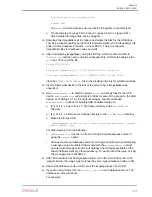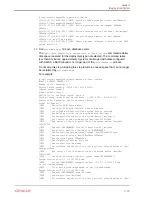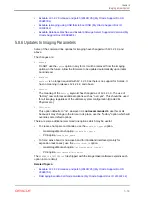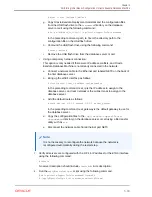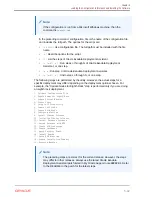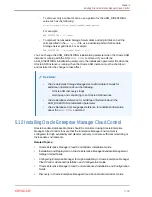
•
•
Configuring DBFS on Oracle Exadata Database Machine (My Oracle Support Doc
ID 1054431.1)
•
Oracle Exadata Best Practices (My Oracle Support Doc ID 757552.1)
See Also:
•
Oracle Automatic Storage Management Administrator's Guide for
additional information about starting and connecting to an Oracle ASM
instance
•
Oracle Exadata System Software User's Guide for additional information
about I/O resources
•
Oracle Exadata System Software User's Guide for information about
configuring the database servers to use Exadata Storage Servers
5.11.2.1 Configuring the Compatible Parameter for a Database Instance
To configure a database instance to access cell storage, ensure that the
COMPATIBLE parameter is set to 11.2.0.2 or later in the database initialization file.
Oracle recommends using the best practices for Oracle Exadata Storage Server
Software available at My Oracle Support.
You can view the initialization parameter file from the operating system or use the
SQL*Plus administration command
SHOW PARAMETER
if the database is running. For
example:
SQL> SHOW PARAMETER
SQL> SHOW PARAMETER compatible
If necessary, set the COMPATIBLE initialization parameter in the initialization
parameter file to
11.2.0.2
or later. For example:
COMPATIBLE='11.2.0.2'
The COMPATIBLE parameter cannot be changed dynamically. If you change the
value in the initialization parameter file, then the database must be shut down and
restarted for the change to take effect.
5.11.2.2 Configuring Initialization Parameters for an Oracle ASM Instance
To enable an Oracle ASM instance to discover and access Exadata Storage Server
grid disks, you must configure the ASM_DISKSTRING initialization parameter as
follows:
•
Set the ASM_DISKSTRING initialization parameter to the empty string (
''
) to
discover all grid disks on the cells listed in the
cellip.ora
file. This causes Oracle
ASM discovery for
/dev/raw/*
and any ASMLIB disks on any non-Exadata Storage
Servers.
•
Set the ASM_DISKSTRING initialization parameter to restrict the discovery by
Oracle ASM to only specific sets of disks, as shown in the examples.
Chapter 5
Loading the Configuration Information and Installing the Software
5-95

